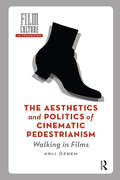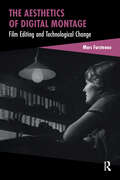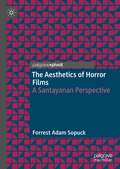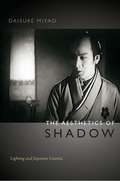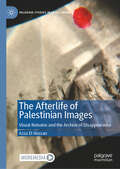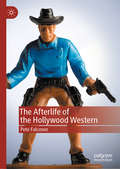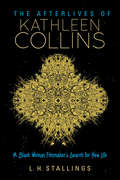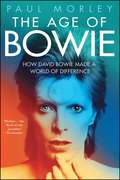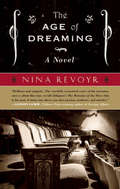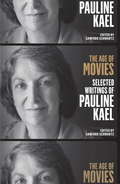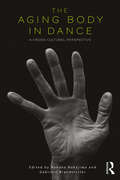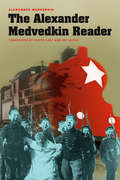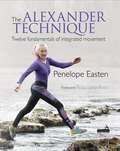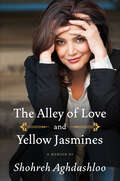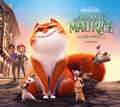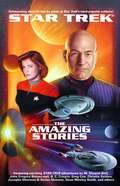- Table View
- List View
The Aesthetics and Politics of Cinematic Pedestrianism: Walking in Films (Film Culture in Transition)
by Asli ÖzgenThe Aesthetics and Politics of Cinematic Pedestrianism: Walking in Films offers a rich exploration of the cinematic aesthetics that filmmakers devised to reflect the corporeal and affective experience of walking in the city. Drawing from literature in urban studies, film theory, and aesthetic philosophy, it is the first monograph to approach the history of cinema from the perspective of walking. A series of case studies providing nuanced analyses of widely referenced figures, such as the flaneur/flâneuse, vagabond, and nomad, reveal how filmmakers articulated their objection to repressive structures through depictions of walking: a common, everyday act yet transgressive, bold, and indomitable. Through the lens of Henri Lefebvre’s theory of space, Michel de Certeau’s concept of pedestrian acts, and Jacques Rancière’s treatment of the politics of aesthetics, Walking in Films traces how cinema evolved in conversation with the mobile body and the new images, styles, and techniques that emerged with it. Winner of the 2023 Best Book Award from the Amsterdam School of Cultural Analysis (ASCA).
The Aesthetics of Digital Montage: Film Editing and Technological Change (Cinema and Technology)
by Marc FurstenauTracing the recent changes to the technology of film editing, this book offers an account of the aesthetics of digital montage. It is commonly argued that the changes to the technical apparatus of editing, the emergence of new systems for digital editing, have altered the basic identity or ontology of the cinema as an art. Such claims, it is argued in this book, are based on a misunderstanding of the relation between technology and technique, and more generally between the technical and the aesthetic. Applying recent theories of art, and employing specific concepts from philosophical aesthetics, an account of cinematic art is offered that can better accommodate the kinds of technical changes that have occurred in recent decades, with the advent of computer technology in the cinema. An aesthetics of digital montage is presented as part of a more general proposal for a theory of technical change in the cinema.
The Aesthetics of Horror Films: A Santayanan Perspective
by Forrest Adam SopuckThis book analyzes the nature and functions of horror films from the vantage of a theoretical reconstruction of George Santayana’s account of beauty. This neo-Santayanan framework forms the conceptual backdrop for a new model of horror’s aesthetic enjoyment, the nature of which is detailed through the examination of plot, cinematic, and visual devices distinctive of the popular genre. According to this model, the audience derives pleasure from the films through confronting the aversive scenarios they communicate and rationalizing a denial of their personal applicability. The films then come to embody these acts of self-assertion and intellectual overcoming and become objects of pride. How horror films can acquire necropolitical functions within the context of abusive systems of power is also clarified. These functions, which exploit the power of anti-tragedy, downward social comparison, or vicarious emotion, work to remediate aggressive, ascetic, or revolutionary impulses in ways that are not injurious to the status quo. This book champions horror as a source of self-empowerment and unmitigated beauty, but also attests to the potential social harms of the genre.
The Aesthetics of Shadow: Lighting and Japanese Cinema
by Daisuke MiyaoIn this revealing study, Daisuke Miyao explores "the aesthetics of shadow" in Japanese cinema in the first half of the twentieth century. This term, coined by the production designer Yoshino Nobutaka, refers to the perception that shadows add depth and mystery. Miyao analyzes how this notion became naturalized as the representation of beauty in Japanese films, situating Japanese cinema within transnational film history. He examines the significant roles lighting played in distinguishing the styles of Japanese film from American and European film and the ways that lighting facilitated the formulation of a coherent new Japanese cultural tradition. Miyao discusses the influences of Hollywood and German cinema alongside Japanese Kabuki theater lighting traditions and the emergence of neon commercial lighting during this period. He argues that lighting technology in cinema had been structured by the conflicts of modernity in Japan, including capitalist transitions in the film industry, the articulation of Japanese cultural and national identity, and increased subjectivity for individuals. By focusing on the understudied element of film lighting and treating cinematographers and lighting designers as essential collaborators in moviemaking, Miyao offers a rereading of Japanese film history.
The Aesthetics of the Oppressed
by Augusto BoalAugusto Boal's workshops and theatre exercises are renowned throughout the world for their life-changing effects. At last this major director, practitioner, and author of many books on community theatre speaks out about the subjects most important to him – the practical work he does with diverse communities, the effects of globalization, and the creative possibilities for all of us.
The After Effects Illusionist: All the Effects in One Complete Guide (All The Effects In One Complete Guide Ser.)
by Chad PerkinsFirst published in 2012. Routledge is an imprint of Taylor & Francis, an informa company.
The Afterlife of Palestinian Images: Visual Remains and the Archive of Disappearance (Palgrave Studies in Arab Cinema)
by Azza El HassanThe Afterlife of Palestinian Images is a groundbreaking study of how colonial violence alters and changes visual objects - which in turn affects how a society and culture relates to its own images. Based on the practice-based creative methodology of Palestinian filmmaker and researcher Azza El Hassan, this book explores the re-use and re-appropriation of photos, film and media equipment that have survived looting and destruction, objects which become a constant reminder of what was and what has been lost. El Hassan goes beyond using these visual remains as simple evidence, demonstrating how artistic engagement can reconfigure them into new narratives and establish a renewed sense of cultural identity. While previous research has explored why colonial structures practice native archive plundering, as well as into how a culture reckons with the absence of archival records, this book uniquely addresses how plundered cultures relate to the actual remains of their archives. As a scholar and an artist, El Hassan reconciles a problematic past and present in the search for a new visual experience emerging out of the ruins, finding ways to move forward after destruction. Additional video content for this book is available through the SN More Media App.
The Afterlife of Texts in Translation: Understanding the Messianic in Literature
by Edmund ChapmanThe Afterlife of Texts in Translation: Understanding the Messianic in Literature reads Walter Benjamin’s and Jacques Derrida’s writings on translation as suggesting that texts exist within a process of continual translation. Understanding Benjamin’s and Derrida’s concept of ‘afterlife’ as ‘overliving’, this book proposes that reading Benjamin’s and Derrida’s writings on translation in terms of their wider thought on language and history suggests that textuality itself possesses a ‘messianic’ quality. Developing this idea in relation to the many rewritings and translations of Don Quijote, particularly the multiple rewritings by Jorge Luis Borges, Edmund Chapman asserts that texts consist of a structure of potential for endless translation that continually promises the overcoming of language, history and textuality itself.
The Afterlife of the Hollywood Western
by Pete FalconerThis book examines the Western genre in the period since Westerns ceased to be a regular feature of Hollywood filmmaking. For most of the 20th Century, the Western was a major American genre. The production of Westerns decreased in the 1960s and 1970s; by the 1980s, it was apparent that the genre occupied a less prominent position in popular culture. After an extended period as one of the most prolific Hollywood genres, the Western entered its “afterlife”. What does it now mean for a Hollywood movie to be a Western, and how does this compare to the ways in which the genre has been understood at other points in its history? This book considers the conditions in which the Western has found itself since the 1980s, the latter-day associations that the genre has acquired and the strategies that more recent Westerns have developed in response to their changed context.
The Afterlives of Kathleen Collins: A Black Woman Filmmaker's Search for New Life (Studies in the Cinema of the Black Diaspora)
by L. H. StallingsAn absorbing portrait of a groundbreaking Black woman filmmaker.Kathleen Collins (1942–88) was a visionary and influential Black filmmaker. Beginning with her short film The Cruz Brothers and Miss Malloy and her feature film Losing Ground, Collins explored new dimensions of what narrative film could and should do. However, her achievements in filmmaking were part of a greater life project. In this critically imaginative study of Collins, L.H. Stallings narrates how Collins, as a Black woman writer and filmmaker, sought to change the definition of life and living. The Afterlives of Kathleen Collins: A Black Woman Filmmaker's Search for New Life explores the global significance and futurist implications of filmmaker and writer Kathleen Collins. In addition to her two films, Stallings examines the broad and expansive and varying forms of writing produced by Collins during her short life time. The Afterlives of Kathleen Collins showcases how Collins used filmmaking, writing, and teaching to assert herself as a poly-creative dedicated to asking and answering difficult philosophical questions about human being and living. Interrogating the ideological foundation of life-writing and cinematic life-writing as they intersect with race and gender, Stallings intervenes on the delimited concepts of life and Black being that impeded wider access, distribution, and production of Collins's personal, cinematic, literary, and theatrical works.The Afterlives of Kathleen Collins definitively emphasizes the evolution of film and film studies that Collins makes possible for current and future generations of filmmakers.
The Age of Bowie
by Paul Morley'A handsome six footer with a warm and engaging personality, Davie Jones has all it takes to get to the show business heights including . . . talent.' David Bowie at 17 in May, 1964 writing his own press biography. Respected arts commentator Paul Morley, one of the team who curated the highly successful retrospective exhibition for the Victoria & Albert Museum in London, David Bowie Is . . . constructs the definitive story of Bowie that explores how he worked, played, aged, structured his ideas, invented the future and entered history as someone who could and would never be forgotten. Morley will capture the greatest moments of Bowie's career; from the recording studio with the likes of Brian Eno and Tony Visconti; to iconic live performances from the 1970s, 80s and 90s, as well as the various encounters and artistic relationships he developed with rock luminaries John Lennon, Lou Reed and Iggy Pop. And of course, discuss in detail his much-heralded, and critically-acclaimed comeback with the release of Black Star just days before his shocking death in New York. Morley will offer a startling biographical critique of David Bowie's legacy, showing how he never stayed still even when he withdrew from the spotlight, how he always knew his own worth, and released a dazzling plethora of mobile Bowies into the world with a bloody-minded determination and a voluptuous imagination to create something amazing that was not there before.
The Age of Bowie: How David Bowie Made A World Of Difference
by Paul MorleyAuthor and industry insider Paul Morley explores the musical and cultural legacies left behind by "The Man Who Fell to Earth."Respected arts commentator and author Paul Morley, an artistic advisor to the curators of the highly successful retrospective exhibition David Bowie is for the Victoria & Albert Museum in London, constructs a definitive story of Bowie that explores how he worked, played, aged, structured his ideas, influenced others, invented the future, and entered history as someone who could and would never be forgotten. Morley captures the greatest moments from across Bowie's life and career; how young Davie Jones of South London became the international David Bowie; his pioneering collaborations in the recording studio with the likes of Tony Visconti, Mick Ronson, and Brian Eno; to iconic live, film, theatre, and television performances from the 1970s, 80s, and 90s, as well as the various encounters and artistic relationships he developed with musicians from John Lennon, Lou Reed, and Iggy Pop to Trent Reznor and Arcade Fire. And of course, discusses in detail his much-heralded and critically acclaimed finale with the release of Blackstar just days before his shocking death in New York. Morley offers a startling biographical critique of David Bowie's legacy, showing how he never stayed still even when he withdrew from the spotlight, how he always knew his own worth, and released a dazzling plethora of personalities, concepts, and works into the world with a single-minded determination and a voluptuous imagination to create something the likes of which the world had never seen before--and likely will never see again.
The Age of Dreaming: A Novel
by Nina Revoyr"The Age of Dreaming is a masterpiece of the sort that doesn't just seduce the reader-it leaves you transformed. Nina Revoyr deserves to be counted among the top ranks of novelists at work today."-Jerry Stahl, author of I, Fatty"This is a riveting, wise, and gorgeous novel."-Mary Yukari Waters"Brilliant and original. . . . The carefully restrained voice of its narrator recalls Ishiguro's The Remains of the Day."-Alison Lurie, Pulitzer Prize winnerJun Nakayama was a silent film star in the early days of Hollywood, but by 1964, he is living in complete obscurity-until a young writer, Nick Bellinger, reveals that he has written a screenplay with Nakayama in mind. Jun is intrigued by the possibility of returning to movies, but he begins to worry that someone might delve too deeply into the past and uncover the events that led to the abrupt end of his career in 1922. These events include the changing racial tides in California and the unsolved murder of his favorite director, Ashley Bennett Tyler.The Age of Dreaming is part historical novel, part mystery, and part unrequited love story.Nina Revoyr was born in Tokyo to a Japanese mother and a Polish-American father, and grew up in Japan, Wisconsin, and Los Angeles. She is the author of two previous novels, The Necessary Hunger and Southland, which was a Book Sense 76 pick, winner of the Ferro-Grumley and Lambda Literary awards, a finalist for an Edgar Award, and one of the Los Angeles Times' "Best Books of 2003." She lives and works in Los Angeles.
The Age of Movies: Selected Writings of Pauline Kael
by Pauline Kael Sanford Schwartz"Film criticism is exciting just because there is no formula to apply," Pauline Kael once observed, "just because you must use everything you are and everything you know." Between 1968 and 1991, as regular film reviewer for The New Yorker, Kael used those formidable tools to shape the tastes of a generation, enthralling readers with her gift for capturing, with force and fluency, the essence of an actor's gesture or the full implication of a cinematic image. Kael called movies "the most total and encompassing art form we have," and she made her reviews a platform for considering both film and the worlds it engages, crafting in the process a prose style of extraordinary wit, precision, and improvisatory grace. To read The Age of Movies, the first new selection in more than a generation, is to be swept up into an endlessly revealing and entertaining dialogue with Kael at her witty, exhilarating, and opinionated best. Her ability to evoke the essence of a great artist-an Orson Welles or a Robert Altman-or to celebrate the way even seeming trash could tap deeply into our emotions was matched by her unwavering eye for the scams and self-deceptions of a corrupt movie industry. Here in this career spanning collection are her appraisals of the films that defined an era-among them Breathless, Bonnie and Clyde, The Leopard, The Godfather, Last Tango in Paris, Nashville-along with many others, some awaiting rediscovery, all providing the occasion for masterpieces of observation and insight, alive on every page.
The Age of the Image: Redefining Literacy in a World of Screens
by Stephen ApkonAn urgent, erudite, and practical book that redefines literacy to embrace how we think and communicate nowWe live in a world that is awash in visual storytelling. The recent technological revolutions in video recording, editing, and distribution are more akin to the development of movable type than any other such revolution in the last five hundred years. And yet we are not popularly cognizant of or conversant with visual storytelling's grammar, the coded messages of its style, and the practical components of its production. We are largely, in a word, illiterate. But this is not a gloomy diagnosis of the collapse of civilization; rather, it is a celebration of the progress we've made and an exhortation and a plan to seize the potential we're poised to enjoy. The rules that define effective visual storytelling—much like the rules that define written language—do in fact exist, and Stephen Apkon has long experience in deploying them, teaching them, and witnessing their power in the classroom and beyond. In The Age of the Image, drawing on the history of literacy—from scroll to codex, scribes to printing presses, SMS to social media—on the science of how various forms of storytelling work on the human brain, and on the practical value of literacy in real-world situations, Apkon convincingly argues that now is the time to transform the way we teach, create, and communicate so that we can all step forward together into a rich and stimulating future.
The Agglomeration of the Animation Industry in East Asia
by Kenta YamamotoThis book will be of interest to scholars and students of Asian studies, cultural industries, economic geography, and related areas of study. It discusses the results of a microscopic survey focusing on topics such as how animation studios form business relationships and how workers gain skills in the industry. The methodology was based on traditional Japanese economic geographical methods. The study also examines macroscopic issues such as why industrial agglomerations are formed in metropolises, why metropolises develop mutual networks, and how a type of cultural product is created in the metropolises. The methodology uses case studies of the animation industries in Japan, South Korea, and China. The detailed analysis covers the process of the industry's agglomeration within the East Asian metropolises of Tokyo, Seoul, and Shanghai as well as the division of labor among them. In addition, the transaction relationships among animation studios are examined, together with the promotion of the industry in the peripheral region of Okinawa, Japan. Differences in work styles and output among these cities are also examined. The research presented in this book contributes to understanding the spatial structure and reality of creativity in an innovative industry, particularly the East Asian content industry.
The Aggretsuko Guide to Office Life: (sanrio Book, Red Panda Comic Character, Kawaii Gift, Quirky Humor For Animal Lovers)
by SanrioA colorful guide to office life as written by the beleaguered twenty-five-year-old red panda and star of the hit Netflix show.Aggretsuko may seem like just a cute, endearing, little red panda, but under the surface, she’s also a fed up office worker who’s tired of being pushed around and ready to snap. In this helpful handbook, she offers tips on how to deal with annual holiday parties, avoid colleagues after hours, circumvent oversharing coworkers, and most importantly—how to RAGE (preferably in heavy-metal karaoke sessions). Featuring art from the popular videos and Sanrio products combined with sidebars and prescriptive tips, this book is a must-have for anyone who needs help staying sane from nine to five.
The Aging Body in Dance: A cross-cultural perspective
by Gabriele Brandstetter Nanako NakajimaWhat does it mean to be able to move? The Aging Body in Dance brings together leading scholars and artists from a range of backgrounds to investigate cultural ideas of movement and beauty, expressiveness and agility. Contributors focus on Euro-American and Japanese attitudes towards aging and performance, including studies of choreographers, dancers and directors from Yvonne Rainer, Martha Graham, Anna Halprin and Roemeo Castellucci to Kazuo Ohno and Kikuo Tomoeda. They draw a fascinating comparison between youth-oriented Western cultures and dance cultures like Japan’s, where aging performers are celebrated as part of the country’s living heritage. The first cross-cultural study of its kind, The Aging Body in Dance offers a vital resource for scholars and practitioners interested in global dance cultures and their differing responses to the world's aging population.
The Alexander Medvedkin Reader
by Nikita Lary Jay Leyda Alexander MedvedkinFilmmaker Alexander Medvedkin (1900-89), a contemporary of Sergei Eisenstein and Alexander Dovzhenko, is celebrated today for his unique form of "total" documentary cinema, which aimed to bridge the distance between film and life, as well as for his use of satire during a period when the Soviet authorities preferred that laughter be confined to narrowly prescribed channels. This collection of selected writings by Medvedkin is the first of its kind and reveals how his work is a crucial link in the history of documentary film. Although he was a dedicated Communist, Medvedkin's satirical approach and social critiques ultimately led to his suppression by the Soviet regime. State institutions held back or marginalized his work, and for many years, his films were assumed to have been lost or destroyed. These texts, many assembled for this volume by Medvedkin himself, document for the first time his considerable achievements, experiments in film and theater, and attempts to develop satire as a major Soviet film genre. Through scripts, letters, autobiographical writings, and more, we see a Medvedkin supported and admired by figures like Eisenstein, Dovzhenko, and Maxim Gorky.
The Alexander Technique: Twelve fundamentals of integrated movement
by Penelope EastenThis book gets back to the core of the Alexander Technique (AT), much of which is not known even to most teachers. This is because Alexander (1869-1955) changed what he was doing at least three times, around 1912, 1923, and 1930, each time leaving key elements behind, unexplained. These lost elements include natural breathing, his biomechanics to alter the body for ourselves, the real thought processes of his directions, how he used inhibition and quiet attentiveness to discover intrinsic movement patterns, and how he used vision as part of his process. There are snippets of AT history throughout, and a potted history of what really happened in the AT, as it has not been told before, but the emphasis is on AT in the context of integrated movement.
The Alley of Love and Yellow Jasmines
by Shohreh AghdashlooOscar nominee and Emmy Award–winning actress Shohreh Aghdashloo shares her remarkable personal journey—from a childhood in the Shah’s Iran to the red carpets of Hollywood—in The Alley of Love and Yellow Jasmines, a dazzling memoir of family, faith, and hope. When Shohreh Aghdashloo was growing up in Teheran, stardom was a distant dream, especially since her parents had more practical plans for their daughter… When revolution swept Iran in 1978, the Ayatollah Khomeini’s religious regime brought stifling restrictions on women and art. Shohreh Aghdashloo seized the moment and boldly left her husband for Europe and eventually, America, a vastly different culture. Shohreh Aghdashloo writes poignantly about her struggles as an outsider in a new culture—as a woman, a Muslim, and a Persian—adapting to a new land and a new language, and shares behind-the-scenes stories about what it’s really like to be an actress in Hollywood.The Alley of Love and Yellow Jasmines includes original color photographs from the author.
The Amah
by Laurence YepTwelve-year-old Amy finds her family responsibilities growing and interfering with her ballet practice when her mother takes a job outside the home.
The Amazing Maurice: The Art of the Film
by Ramin ZahedThe official art book for the animated movie The Amazing Maurice, based on the Carnegie Medal-winning Discworld novel by Terry PratchettMaurice is a streetwise talking tomcat who comes up with a money-making scam by befriending a group of talking rats and finding a dumb-looking kid who plays a pipe. When Maurice and company reach the stricken town of Bad Blintz, they meet a bookworm called Malicia and their scheme soon goes down the drain. The Art of the Film is a coffee table hardback celebration of the creative process of bringing The Amazing Maurice to life, including exclusive concept designs, character sketches, storyboards and production art, alongside insight from the artists, filmmakers and directors.
The Amazing Stories (Star Trek)
by John J OrdoverFrom 1998 to 2000, Amazing Stories, the world's oldest science fiction magazine, presented a series of original Star Trek stories written by a number of bestselling authors. Now these little-seen Star Trek adventures are collected here for the first time, together with new tales written especially for Star Trek: Amazing Stories. Among the highlights of this collection: Spock comes to terms with the death of his father in a touching tale from A.C. Cripsin, author of SAREK; Counsellor Troi risks everything to aid the evacuation of a dying planet; Seven of Nine learns a lesson in humanity when the USS Voyager takes on some unusual alien visitors; Beverley Crusher discovers that holographic doctors take some getting used to, especially during a medical emergency; and Captain Proton, Defender of the Earth, faces the awesome menace of Space Vortex of Doom.
The Amazing World of Video Game Development
by Denis GalaninThe perfect book for any child who is interested in making a career out of video games, learn about the different roles within a game development company and how a game goes from a thought to a program.
